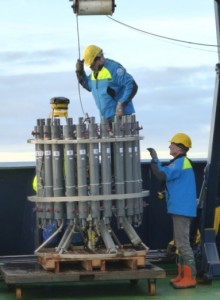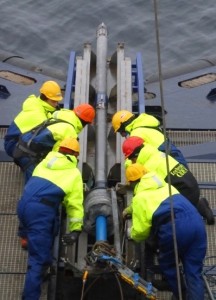26 July 2014, by Matt Shupe [78N, 137E]:
Most measurements made on this voyage are from below, either sampling water or sea-floor sediment. Each primary sampling mode has a team of people working shifts since we can arrive at a station (predefined sampling points) at any hour of the day. Don’t forget, it is always light out here! And we are on UTC time in spite of the fact that we are now at 137E….. so our daily schedule has little to do with the sun! In any case, I find these other sampling programs quite interesting. One is the CTD and rosette, sent over the bow of the ship profiling the water column. It measures temperature, salinity, currents, and fills individual gray tubes full of water at different heights. When back on board, different research groups fill small containers with the water from different heights to conduct a variety of analyses. Ocean water is also sampled via submersible pumps and other large sampling volumes lowered into the water.
There are two sediment coring devices. One, the piston core, is a long pipe with an interesting mechanical weight-release-trigger mechanism that helps it push into the ocean floor when lowered off the side of the ship. Last core was a remarkable 6.5 m long! This represents a vast history of time….. perhaps millenia? Another device is the multi-core, which has many shorter plastic tubes on the bottom that push into the sea floor about 20 cm deep. Much more of this sampling occurs because most scientists here are interested in the more active uppermost layers of sediment. There they study biological processes, bacteria, lipids, oxygen content, and other analyses all aimed at understanding the carbon budget and the role of methane.


